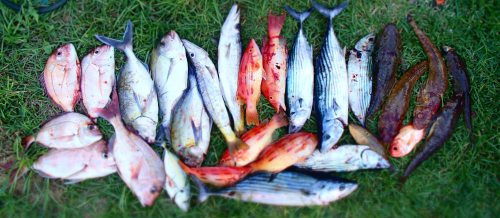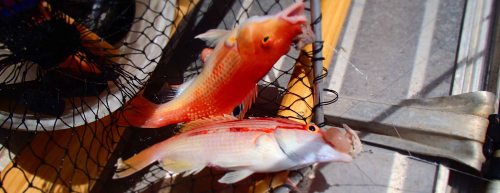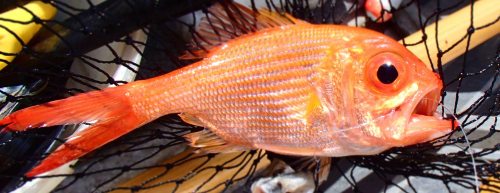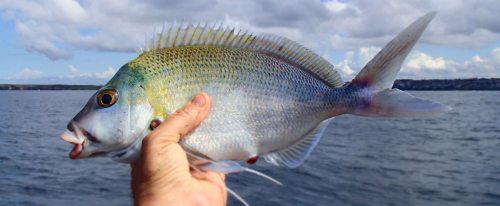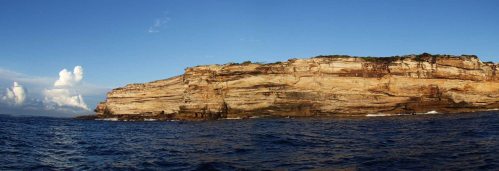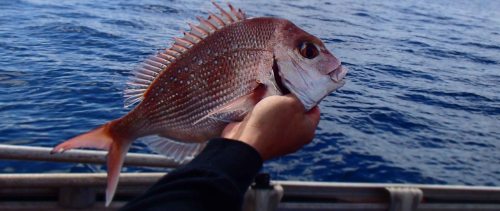
Bonito: Sarda australis
From January to perhaps April my enormous preference for fish, both to catch and to eat, is bonito (Sarda australis). And to be honest, these four months are when I do most of my year’s fishing. A trip on a boat can be relied on for a half-dozen or so of them (sometimes many more), trolling around the headlands. Our last trip last week scored exactly that. In some years (like last year, but unfortunately not this one) there is also a chance that one of the smaller tuna (like striped or mackerel tuna) will hit your lure. While they are the smallest of the tuna, they are still a tuna; and they cook like it and catch like it.
With my lure usually running a little further back than my mate’s, he will often get hit first and drop the boat into neutral (or a slow heading away from the rocks) to begin reeling in. This means I start hauling my lure in on the fastest retrieve I can pull off. It gets my line out of the way of a possible tangle with his and it means that I am hopefully retrieving through the school. Last week, 2 of his 3 hook ups had me onto fish as well this way. It is that little bit more fun to get hit like this, in anticipation of it and ready to really feel the strike through rod and line. Being rigged to handle a possible larger tuna (or kingfish even), the gear isn’t light enough to need to mess around with playing the fish, it is just straight skull-dragging to the boat. Followed by landing, slitting of gill arteries to bleed the flesh as much as possible and into the iced kill box. Then it is a quick turn around and back for more. With a box filling with fish quivering blood into an iced slurry, no one would say it is pretty, but there is a satisfaction to this annual harvest that lasts a whole year. And it is fun, a lot of fun.

Last week's catch of 'bonnies'
With the bad weather of this summer, I have gotten out on only two boat trips. I go on a mate’s pretty small dinghy and we are a little more shy of big swell now after an incident with a wave on a bombora last year put me first in the hospital casualty room and then in bed for a week of back spasm agony. We may manage another outing before the bonnies move on, but failing that there is also spinning off the rocks.
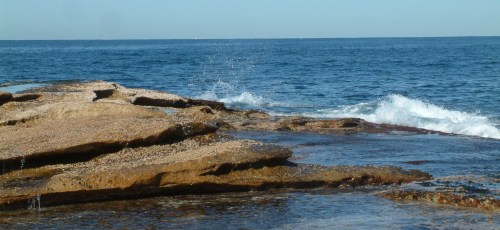
Shark Point on a good day
On a good day, Shark Point juts passively into the Pacific far enough to have a reasonable chance of getting you in the way of passing near-shore pelagic (open ocean) fish like bonito. On a bad day it gives you a more than reasonable chance of getting taken roughly into a less than pacific sea (rock fishing is said to have more deaths than any other sport). On too many mornings in the current weather, the ocean view is like today’s (below), even though on shore it seems like a reasonable day of patchy cloud, gentle wind and just a slight chance of rain. Last week I chanced it, up before dawn and down to the headland to cast into the first rays of the rising sun – I pushed my luck long enough to lose one lure because of fishing too far from the surging water’s edge before quitting while I was ahead and still dry. A lot of rock fishing trips go like that for me – a walk down to the headland to make an obvious choice to walk home again. It’s a very nice walk though. On other times the walk does get to include some vain lure casting into a seemingly empty sea (this also means a spell staring at that sea, that greatest of all wildernesses and therefore a precious interlude in a city life). And then others, the ones easiest to remember, there are fish like the bonito in the first picture of the post. I will keep trying until the water cools to wetsuit temperatures, and then wait again for next year.

No fishing today
One of the beauties of bonito is the ease of eating it. Being great for sashimi and without scales (or at least tiny ones that do not need removal, you could even start chowing down on it straight from the water (although a habit that we reserve for harbour kingfish when we take soy and wasabi out with us in anticipation). With a good sharp knife, fillets come off with an easy and obvious slice. Cuts on either side of the row of bones down the middle (see below) then give you two fillets of which the lower one with ribs gets another slice to remove those. From that piece with the ribs you can then cut a delicious fat little belly flap and have little overall waste. From 3 fish, you get 12 decent fillets and 6 little belly flaps. They freeze well. You might not want to keep fish in the freezer long enough to see you through until the next bonito season, but a few good hauls can still keep you in fish for good part of the year. I’ve had success with a Basque country fish stew called marmitako, Hugh Fearnley Whittingstall’s ‘gravad max’ recipe and have heard hot smoking also works well.
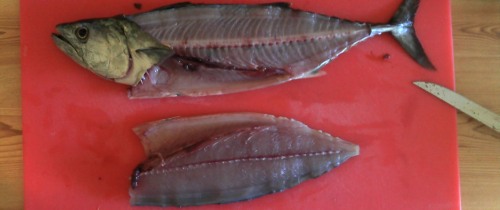
Filleting bonito

The final bonito product
Ask a lot of fishermen about bonito and they will tell you it is great bait; and some will tell you that it is only bait. But if it is bled and fresh it is better than some of the other tunas and really a perfect example of the ‘chicken of the sea’ fishes. Unlike other tunas though, bonito is generally abundant and not overfished. As a commercial catch it is a ‘better choice’ with the Australian Marine Conservation Society, which means that as a recreational catch without bycatch or waste it keeps you on the right fish-eating track.
Read Full Post »
